Business Information Analysis: Apple Inc. Innovation Management Report
VerifiedAdded on 2023/06/10
|12
|2951
|170
Report
AI Summary
This report examines the innovation management practices of Apple Inc., focusing on the challenges and solutions related to managing innovation within the company. It begins with an introduction to Apple Inc., its products, and its historical context, highlighting the importance of innovation in its success. The report then identifies the business problem of managing innovation effectively within the organization, posing research questions to guide the analysis. A literature review explores the importance of constant innovation in the consumer-focused business and the challenges associated with managing it, such as the rejection of ideas, lack of a centralized system, and mapping competitor's innovation. The research methodology involves secondary research and a thorough literature review. The report highlights the evolution of Apple's innovation management strategies, including the introduction of an innovation management software and the impact of its limitations. It also provides recommendations for improving innovation management, emphasizing the importance of technology and coordinated solutions for long-term success. The report concludes by emphasizing the need for effective innovation management to avoid organizational chaos and ensure sustainable business practices.
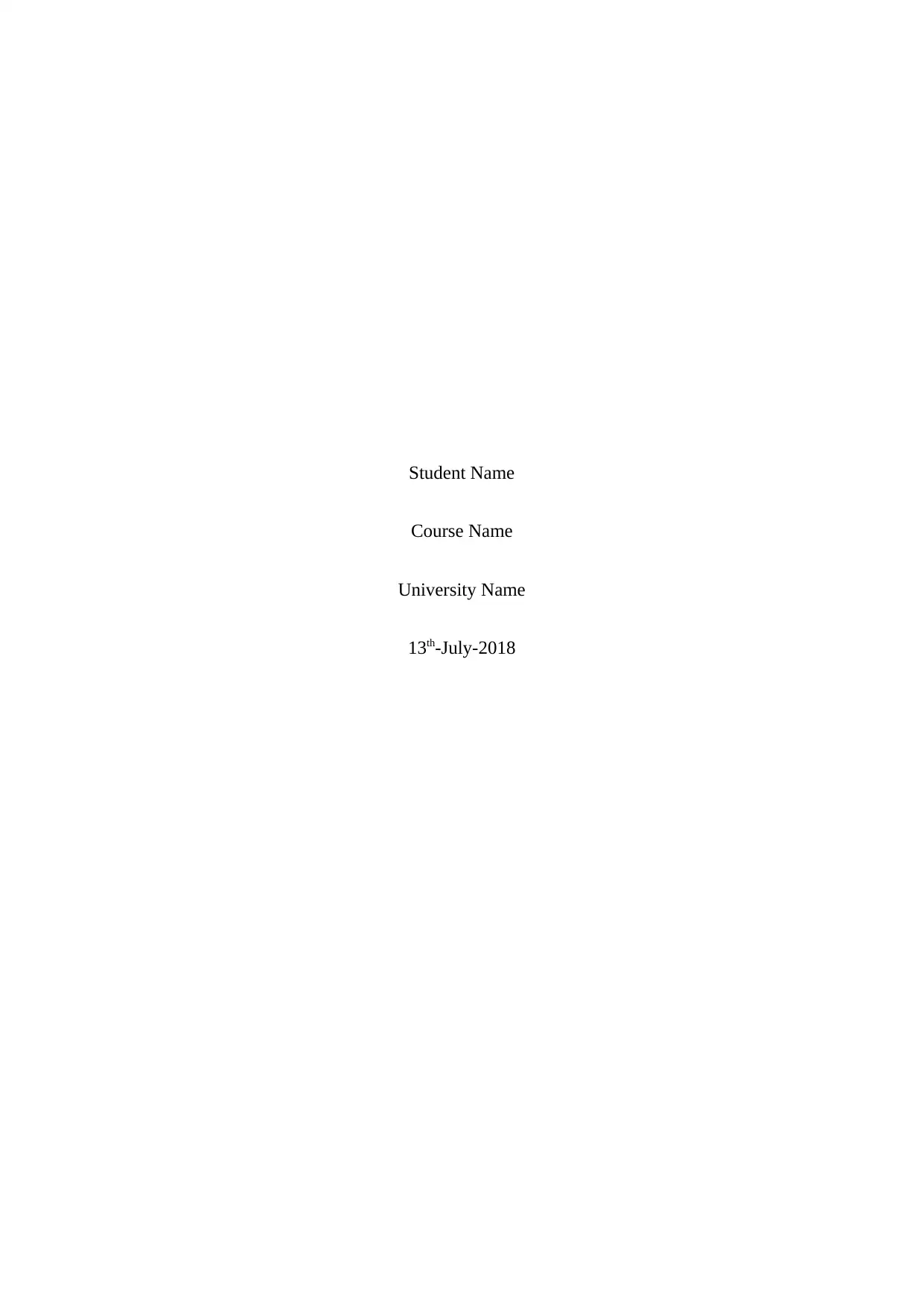
Student Name
Course Name
University Name
13th-July-2018
Course Name
University Name
13th-July-2018
Paraphrase This Document
Need a fresh take? Get an instant paraphrase of this document with our AI Paraphraser
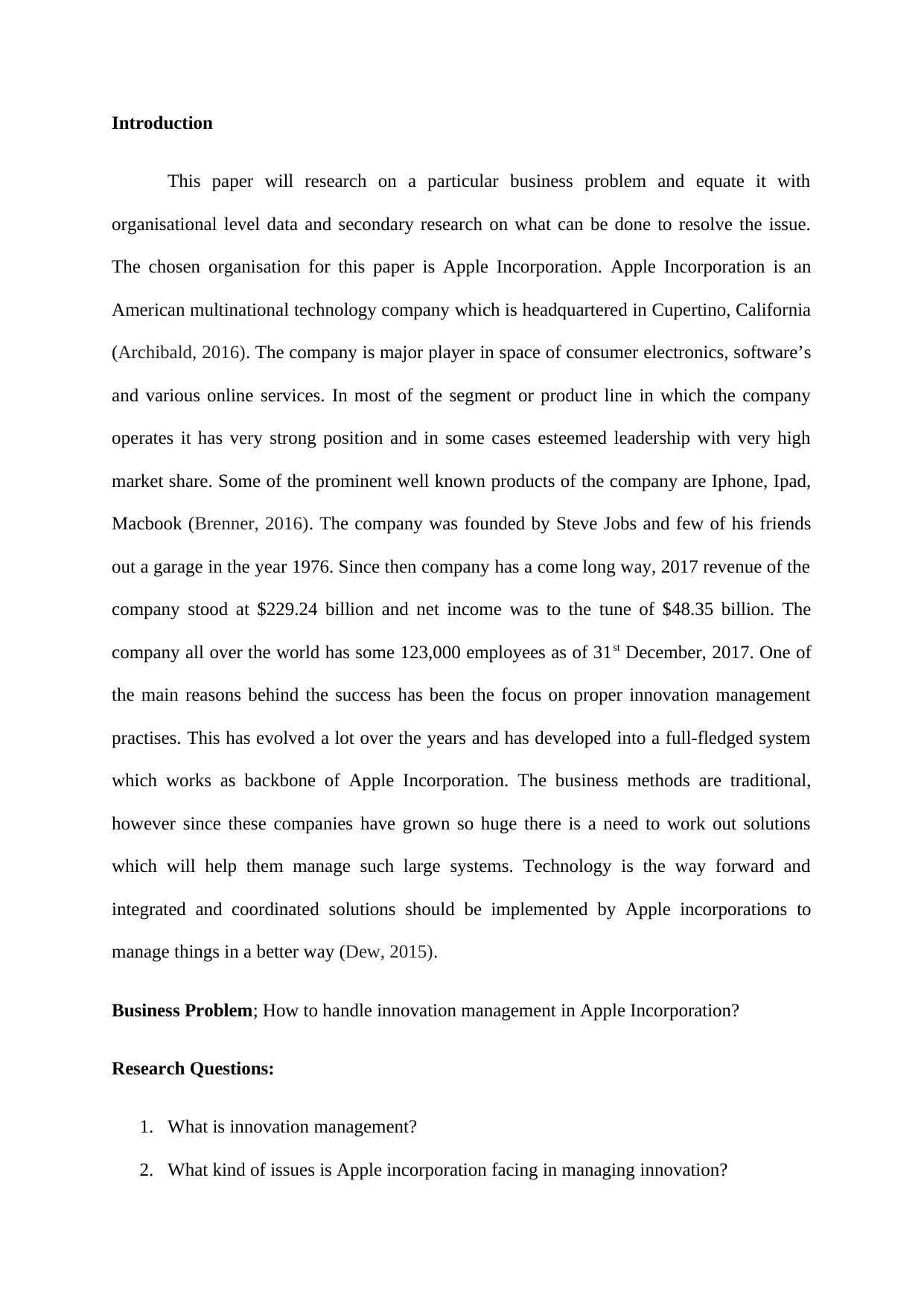
Introduction
This paper will research on a particular business problem and equate it with
organisational level data and secondary research on what can be done to resolve the issue.
The chosen organisation for this paper is Apple Incorporation. Apple Incorporation is an
American multinational technology company which is headquartered in Cupertino, California
(Archibald, 2016). The company is major player in space of consumer electronics, software’s
and various online services. In most of the segment or product line in which the company
operates it has very strong position and in some cases esteemed leadership with very high
market share. Some of the prominent well known products of the company are Iphone, Ipad,
Macbook (Brenner, 2016). The company was founded by Steve Jobs and few of his friends
out a garage in the year 1976. Since then company has a come long way, 2017 revenue of the
company stood at $229.24 billion and net income was to the tune of $48.35 billion. The
company all over the world has some 123,000 employees as of 31st December, 2017. One of
the main reasons behind the success has been the focus on proper innovation management
practises. This has evolved a lot over the years and has developed into a full-fledged system
which works as backbone of Apple Incorporation. The business methods are traditional,
however since these companies have grown so huge there is a need to work out solutions
which will help them manage such large systems. Technology is the way forward and
integrated and coordinated solutions should be implemented by Apple incorporations to
manage things in a better way (Dew, 2015).
Business Problem; How to handle innovation management in Apple Incorporation?
Research Questions:
1. What is innovation management?
2. What kind of issues is Apple incorporation facing in managing innovation?
This paper will research on a particular business problem and equate it with
organisational level data and secondary research on what can be done to resolve the issue.
The chosen organisation for this paper is Apple Incorporation. Apple Incorporation is an
American multinational technology company which is headquartered in Cupertino, California
(Archibald, 2016). The company is major player in space of consumer electronics, software’s
and various online services. In most of the segment or product line in which the company
operates it has very strong position and in some cases esteemed leadership with very high
market share. Some of the prominent well known products of the company are Iphone, Ipad,
Macbook (Brenner, 2016). The company was founded by Steve Jobs and few of his friends
out a garage in the year 1976. Since then company has a come long way, 2017 revenue of the
company stood at $229.24 billion and net income was to the tune of $48.35 billion. The
company all over the world has some 123,000 employees as of 31st December, 2017. One of
the main reasons behind the success has been the focus on proper innovation management
practises. This has evolved a lot over the years and has developed into a full-fledged system
which works as backbone of Apple Incorporation. The business methods are traditional,
however since these companies have grown so huge there is a need to work out solutions
which will help them manage such large systems. Technology is the way forward and
integrated and coordinated solutions should be implemented by Apple incorporations to
manage things in a better way (Dew, 2015).
Business Problem; How to handle innovation management in Apple Incorporation?
Research Questions:
1. What is innovation management?
2. What kind of issues is Apple incorporation facing in managing innovation?
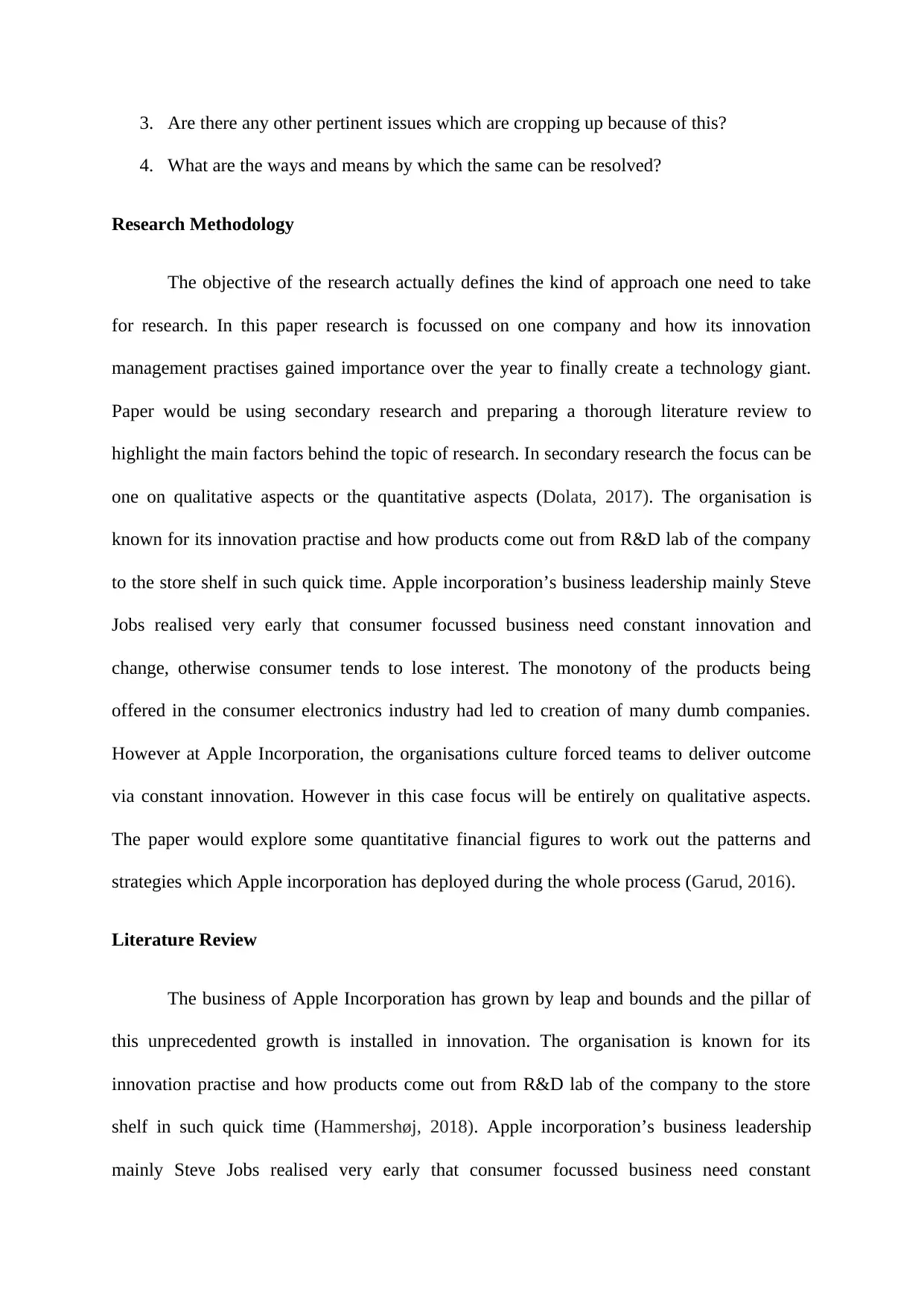
3. Are there any other pertinent issues which are cropping up because of this?
4. What are the ways and means by which the same can be resolved?
Research Methodology
The objective of the research actually defines the kind of approach one need to take
for research. In this paper research is focussed on one company and how its innovation
management practises gained importance over the year to finally create a technology giant.
Paper would be using secondary research and preparing a thorough literature review to
highlight the main factors behind the topic of research. In secondary research the focus can be
one on qualitative aspects or the quantitative aspects (Dolata, 2017). The organisation is
known for its innovation practise and how products come out from R&D lab of the company
to the store shelf in such quick time. Apple incorporation’s business leadership mainly Steve
Jobs realised very early that consumer focussed business need constant innovation and
change, otherwise consumer tends to lose interest. The monotony of the products being
offered in the consumer electronics industry had led to creation of many dumb companies.
However at Apple Incorporation, the organisations culture forced teams to deliver outcome
via constant innovation. However in this case focus will be entirely on qualitative aspects.
The paper would explore some quantitative financial figures to work out the patterns and
strategies which Apple incorporation has deployed during the whole process (Garud, 2016).
Literature Review
The business of Apple Incorporation has grown by leap and bounds and the pillar of
this unprecedented growth is installed in innovation. The organisation is known for its
innovation practise and how products come out from R&D lab of the company to the store
shelf in such quick time (Hammershøj, 2018). Apple incorporation’s business leadership
mainly Steve Jobs realised very early that consumer focussed business need constant
4. What are the ways and means by which the same can be resolved?
Research Methodology
The objective of the research actually defines the kind of approach one need to take
for research. In this paper research is focussed on one company and how its innovation
management practises gained importance over the year to finally create a technology giant.
Paper would be using secondary research and preparing a thorough literature review to
highlight the main factors behind the topic of research. In secondary research the focus can be
one on qualitative aspects or the quantitative aspects (Dolata, 2017). The organisation is
known for its innovation practise and how products come out from R&D lab of the company
to the store shelf in such quick time. Apple incorporation’s business leadership mainly Steve
Jobs realised very early that consumer focussed business need constant innovation and
change, otherwise consumer tends to lose interest. The monotony of the products being
offered in the consumer electronics industry had led to creation of many dumb companies.
However at Apple Incorporation, the organisations culture forced teams to deliver outcome
via constant innovation. However in this case focus will be entirely on qualitative aspects.
The paper would explore some quantitative financial figures to work out the patterns and
strategies which Apple incorporation has deployed during the whole process (Garud, 2016).
Literature Review
The business of Apple Incorporation has grown by leap and bounds and the pillar of
this unprecedented growth is installed in innovation. The organisation is known for its
innovation practise and how products come out from R&D lab of the company to the store
shelf in such quick time (Hammershøj, 2018). Apple incorporation’s business leadership
mainly Steve Jobs realised very early that consumer focussed business need constant
⊘ This is a preview!⊘
Do you want full access?
Subscribe today to unlock all pages.

Trusted by 1+ million students worldwide
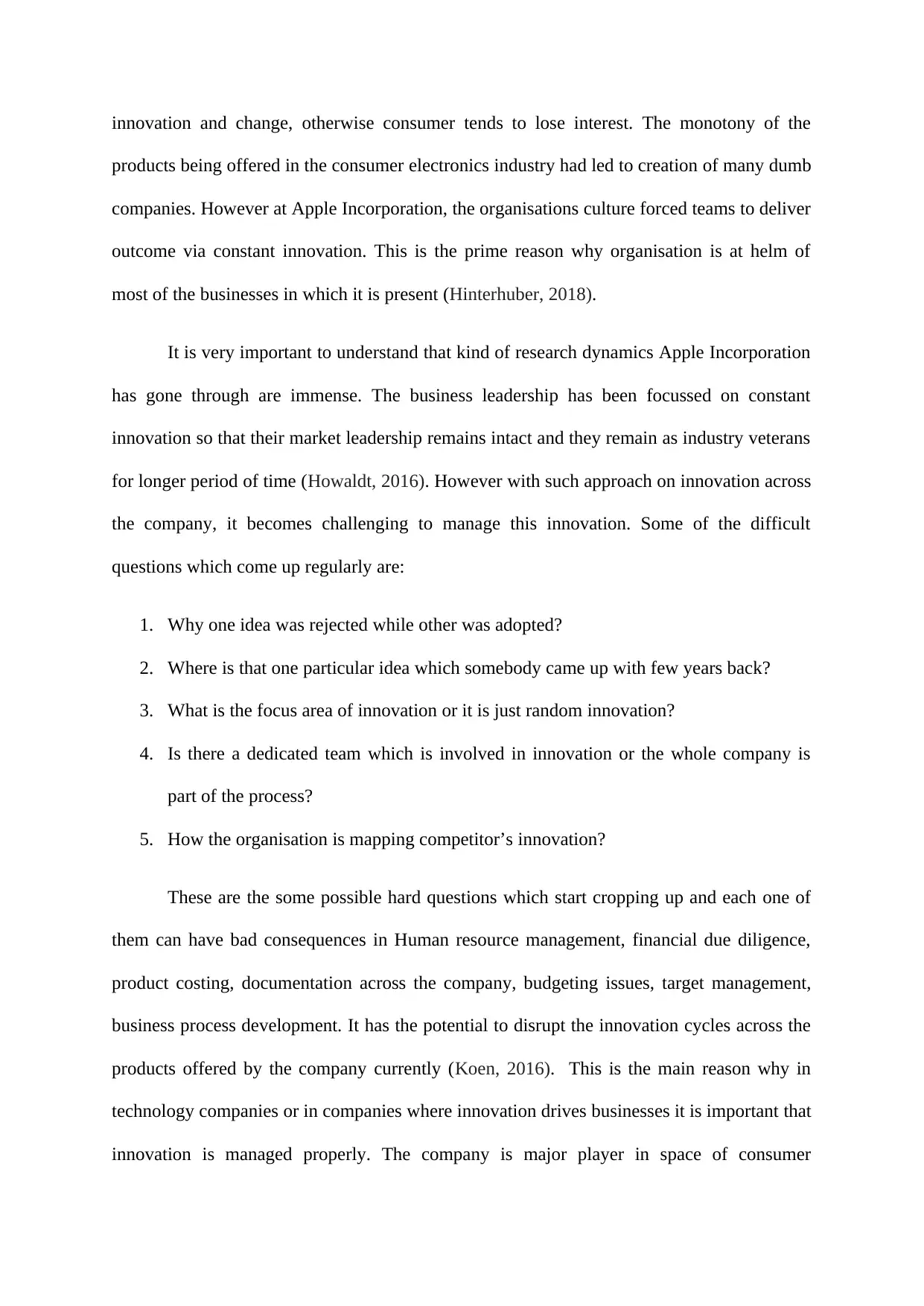
innovation and change, otherwise consumer tends to lose interest. The monotony of the
products being offered in the consumer electronics industry had led to creation of many dumb
companies. However at Apple Incorporation, the organisations culture forced teams to deliver
outcome via constant innovation. This is the prime reason why organisation is at helm of
most of the businesses in which it is present (Hinterhuber, 2018).
It is very important to understand that kind of research dynamics Apple Incorporation
has gone through are immense. The business leadership has been focussed on constant
innovation so that their market leadership remains intact and they remain as industry veterans
for longer period of time (Howaldt, 2016). However with such approach on innovation across
the company, it becomes challenging to manage this innovation. Some of the difficult
questions which come up regularly are:
1. Why one idea was rejected while other was adopted?
2. Where is that one particular idea which somebody came up with few years back?
3. What is the focus area of innovation or it is just random innovation?
4. Is there a dedicated team which is involved in innovation or the whole company is
part of the process?
5. How the organisation is mapping competitor’s innovation?
These are the some possible hard questions which start cropping up and each one of
them can have bad consequences in Human resource management, financial due diligence,
product costing, documentation across the company, budgeting issues, target management,
business process development. It has the potential to disrupt the innovation cycles across the
products offered by the company currently (Koen, 2016). This is the main reason why in
technology companies or in companies where innovation drives businesses it is important that
innovation is managed properly. The company is major player in space of consumer
products being offered in the consumer electronics industry had led to creation of many dumb
companies. However at Apple Incorporation, the organisations culture forced teams to deliver
outcome via constant innovation. This is the prime reason why organisation is at helm of
most of the businesses in which it is present (Hinterhuber, 2018).
It is very important to understand that kind of research dynamics Apple Incorporation
has gone through are immense. The business leadership has been focussed on constant
innovation so that their market leadership remains intact and they remain as industry veterans
for longer period of time (Howaldt, 2016). However with such approach on innovation across
the company, it becomes challenging to manage this innovation. Some of the difficult
questions which come up regularly are:
1. Why one idea was rejected while other was adopted?
2. Where is that one particular idea which somebody came up with few years back?
3. What is the focus area of innovation or it is just random innovation?
4. Is there a dedicated team which is involved in innovation or the whole company is
part of the process?
5. How the organisation is mapping competitor’s innovation?
These are the some possible hard questions which start cropping up and each one of
them can have bad consequences in Human resource management, financial due diligence,
product costing, documentation across the company, budgeting issues, target management,
business process development. It has the potential to disrupt the innovation cycles across the
products offered by the company currently (Koen, 2016). This is the main reason why in
technology companies or in companies where innovation drives businesses it is important that
innovation is managed properly. The company is major player in space of consumer
Paraphrase This Document
Need a fresh take? Get an instant paraphrase of this document with our AI Paraphraser
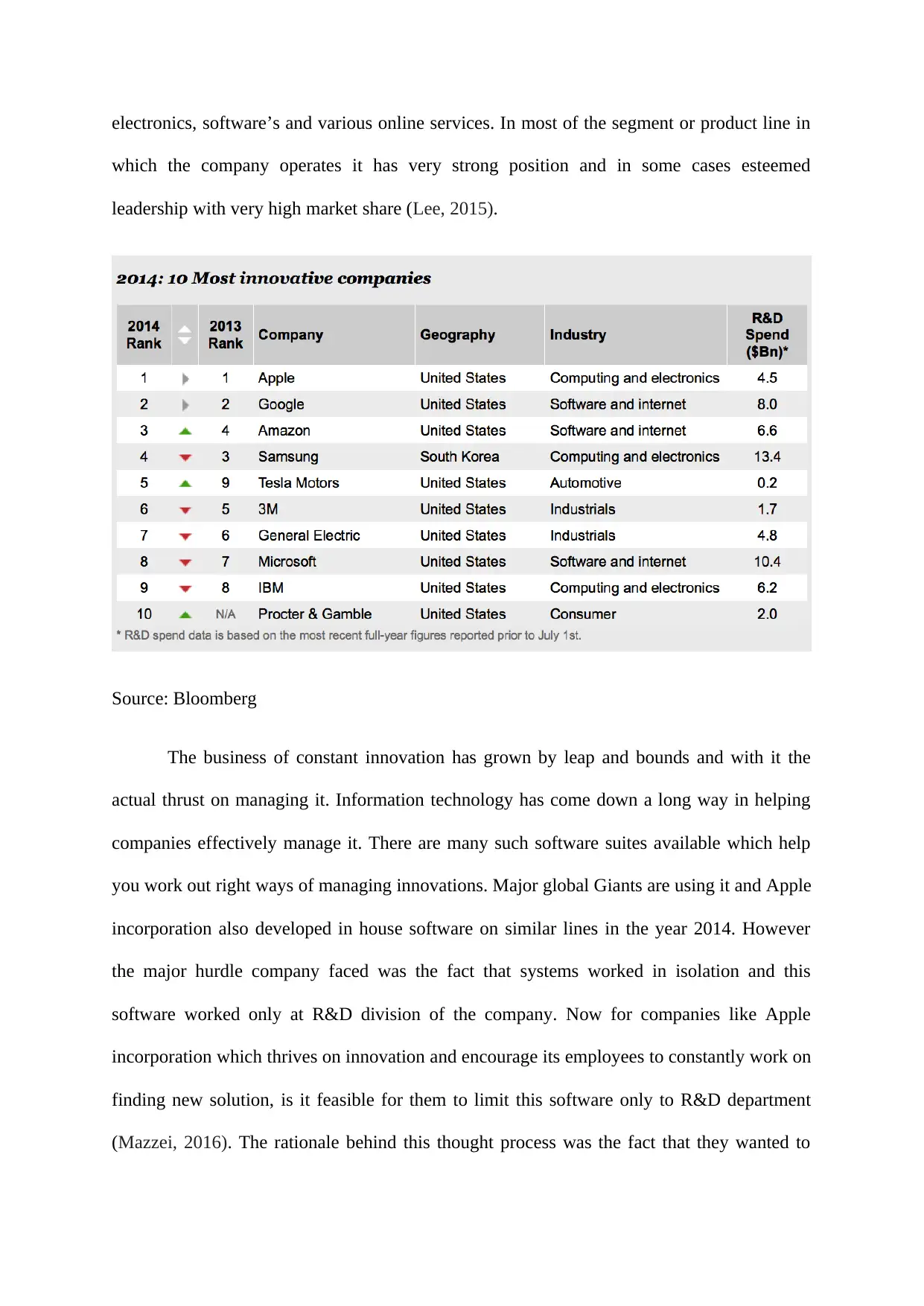
electronics, software’s and various online services. In most of the segment or product line in
which the company operates it has very strong position and in some cases esteemed
leadership with very high market share (Lee, 2015).
Source: Bloomberg
The business of constant innovation has grown by leap and bounds and with it the
actual thrust on managing it. Information technology has come down a long way in helping
companies effectively manage it. There are many such software suites available which help
you work out right ways of managing innovations. Major global Giants are using it and Apple
incorporation also developed in house software on similar lines in the year 2014. However
the major hurdle company faced was the fact that systems worked in isolation and this
software worked only at R&D division of the company. Now for companies like Apple
incorporation which thrives on innovation and encourage its employees to constantly work on
finding new solution, is it feasible for them to limit this software only to R&D department
(Mazzei, 2016). The rationale behind this thought process was the fact that they wanted to
which the company operates it has very strong position and in some cases esteemed
leadership with very high market share (Lee, 2015).
Source: Bloomberg
The business of constant innovation has grown by leap and bounds and with it the
actual thrust on managing it. Information technology has come down a long way in helping
companies effectively manage it. There are many such software suites available which help
you work out right ways of managing innovations. Major global Giants are using it and Apple
incorporation also developed in house software on similar lines in the year 2014. However
the major hurdle company faced was the fact that systems worked in isolation and this
software worked only at R&D division of the company. Now for companies like Apple
incorporation which thrives on innovation and encourage its employees to constantly work on
finding new solution, is it feasible for them to limit this software only to R&D department
(Mazzei, 2016). The rationale behind this thought process was the fact that they wanted to
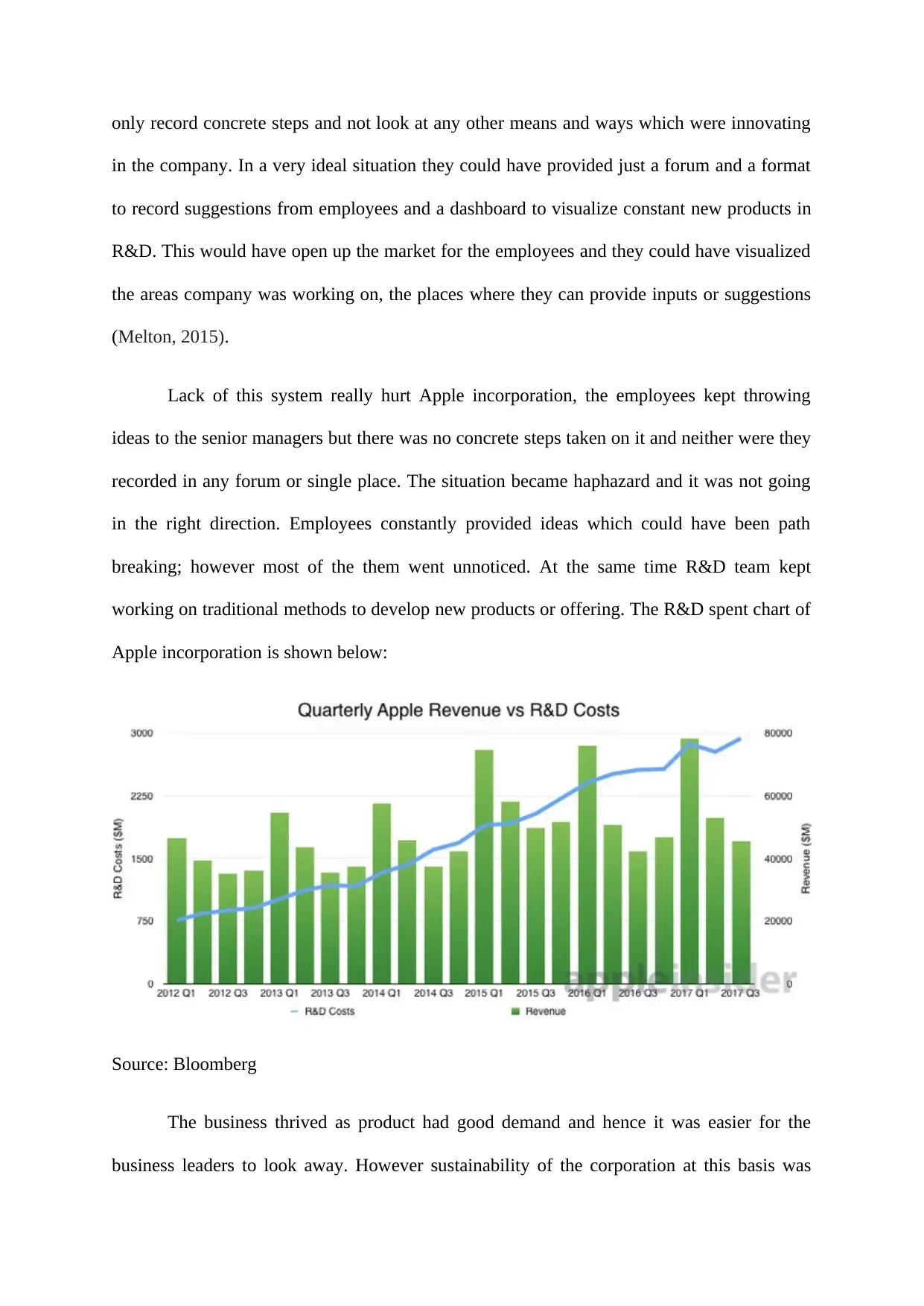
only record concrete steps and not look at any other means and ways which were innovating
in the company. In a very ideal situation they could have provided just a forum and a format
to record suggestions from employees and a dashboard to visualize constant new products in
R&D. This would have open up the market for the employees and they could have visualized
the areas company was working on, the places where they can provide inputs or suggestions
(Melton, 2015).
Lack of this system really hurt Apple incorporation, the employees kept throwing
ideas to the senior managers but there was no concrete steps taken on it and neither were they
recorded in any forum or single place. The situation became haphazard and it was not going
in the right direction. Employees constantly provided ideas which could have been path
breaking; however most of the them went unnoticed. At the same time R&D team kept
working on traditional methods to develop new products or offering. The R&D spent chart of
Apple incorporation is shown below:
Source: Bloomberg
The business thrived as product had good demand and hence it was easier for the
business leaders to look away. However sustainability of the corporation at this basis was
in the company. In a very ideal situation they could have provided just a forum and a format
to record suggestions from employees and a dashboard to visualize constant new products in
R&D. This would have open up the market for the employees and they could have visualized
the areas company was working on, the places where they can provide inputs or suggestions
(Melton, 2015).
Lack of this system really hurt Apple incorporation, the employees kept throwing
ideas to the senior managers but there was no concrete steps taken on it and neither were they
recorded in any forum or single place. The situation became haphazard and it was not going
in the right direction. Employees constantly provided ideas which could have been path
breaking; however most of the them went unnoticed. At the same time R&D team kept
working on traditional methods to develop new products or offering. The R&D spent chart of
Apple incorporation is shown below:
Source: Bloomberg
The business thrived as product had good demand and hence it was easier for the
business leaders to look away. However sustainability of the corporation at this basis was
⊘ This is a preview!⊘
Do you want full access?
Subscribe today to unlock all pages.

Trusted by 1+ million students worldwide
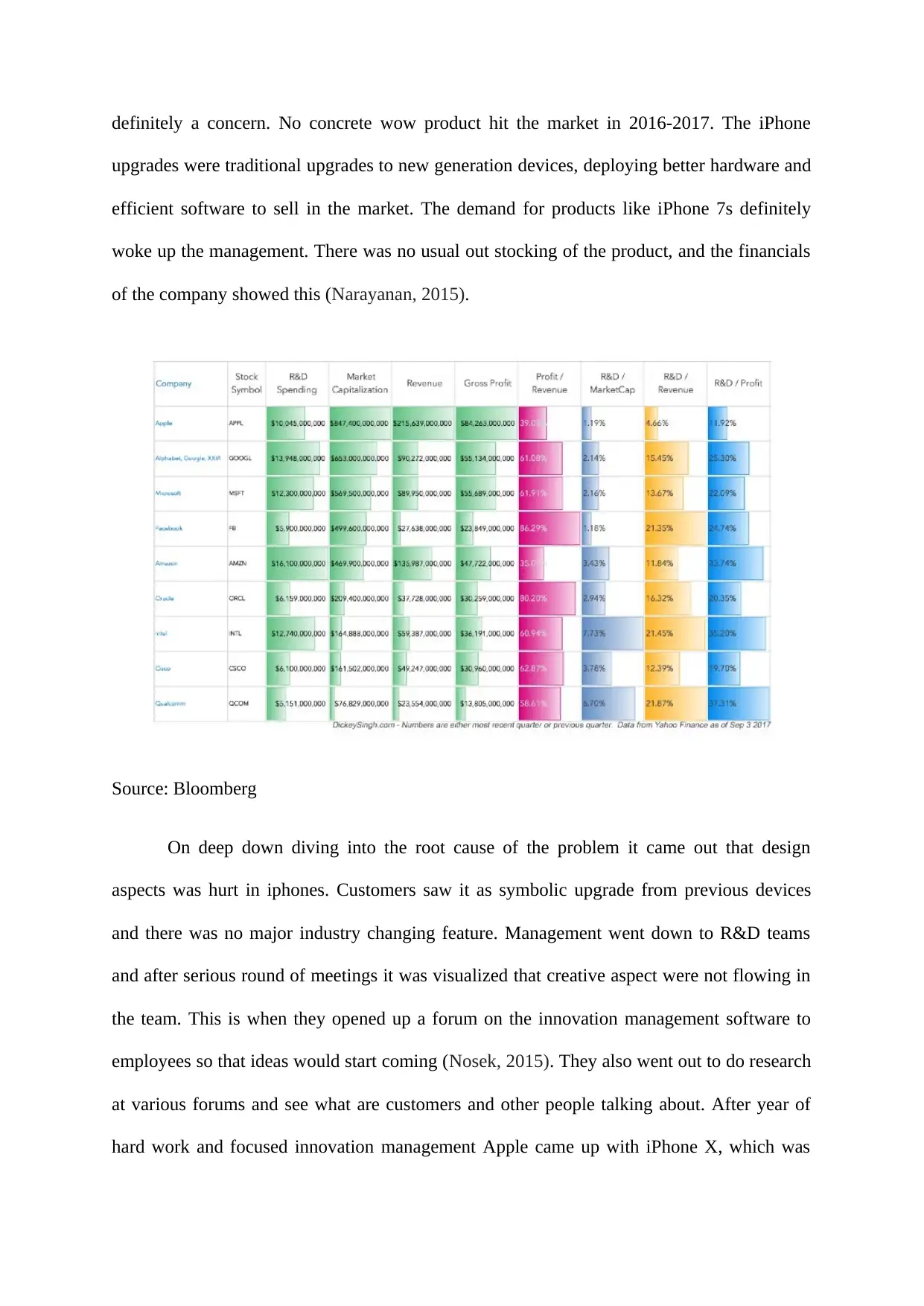
definitely a concern. No concrete wow product hit the market in 2016-2017. The iPhone
upgrades were traditional upgrades to new generation devices, deploying better hardware and
efficient software to sell in the market. The demand for products like iPhone 7s definitely
woke up the management. There was no usual out stocking of the product, and the financials
of the company showed this (Narayanan, 2015).
Source: Bloomberg
On deep down diving into the root cause of the problem it came out that design
aspects was hurt in iphones. Customers saw it as symbolic upgrade from previous devices
and there was no major industry changing feature. Management went down to R&D teams
and after serious round of meetings it was visualized that creative aspect were not flowing in
the team. This is when they opened up a forum on the innovation management software to
employees so that ideas would start coming (Nosek, 2015). They also went out to do research
at various forums and see what are customers and other people talking about. After year of
hard work and focused innovation management Apple came up with iPhone X, which was
upgrades were traditional upgrades to new generation devices, deploying better hardware and
efficient software to sell in the market. The demand for products like iPhone 7s definitely
woke up the management. There was no usual out stocking of the product, and the financials
of the company showed this (Narayanan, 2015).
Source: Bloomberg
On deep down diving into the root cause of the problem it came out that design
aspects was hurt in iphones. Customers saw it as symbolic upgrade from previous devices
and there was no major industry changing feature. Management went down to R&D teams
and after serious round of meetings it was visualized that creative aspect were not flowing in
the team. This is when they opened up a forum on the innovation management software to
employees so that ideas would start coming (Nosek, 2015). They also went out to do research
at various forums and see what are customers and other people talking about. After year of
hard work and focused innovation management Apple came up with iPhone X, which was
Paraphrase This Document
Need a fresh take? Get an instant paraphrase of this document with our AI Paraphraser
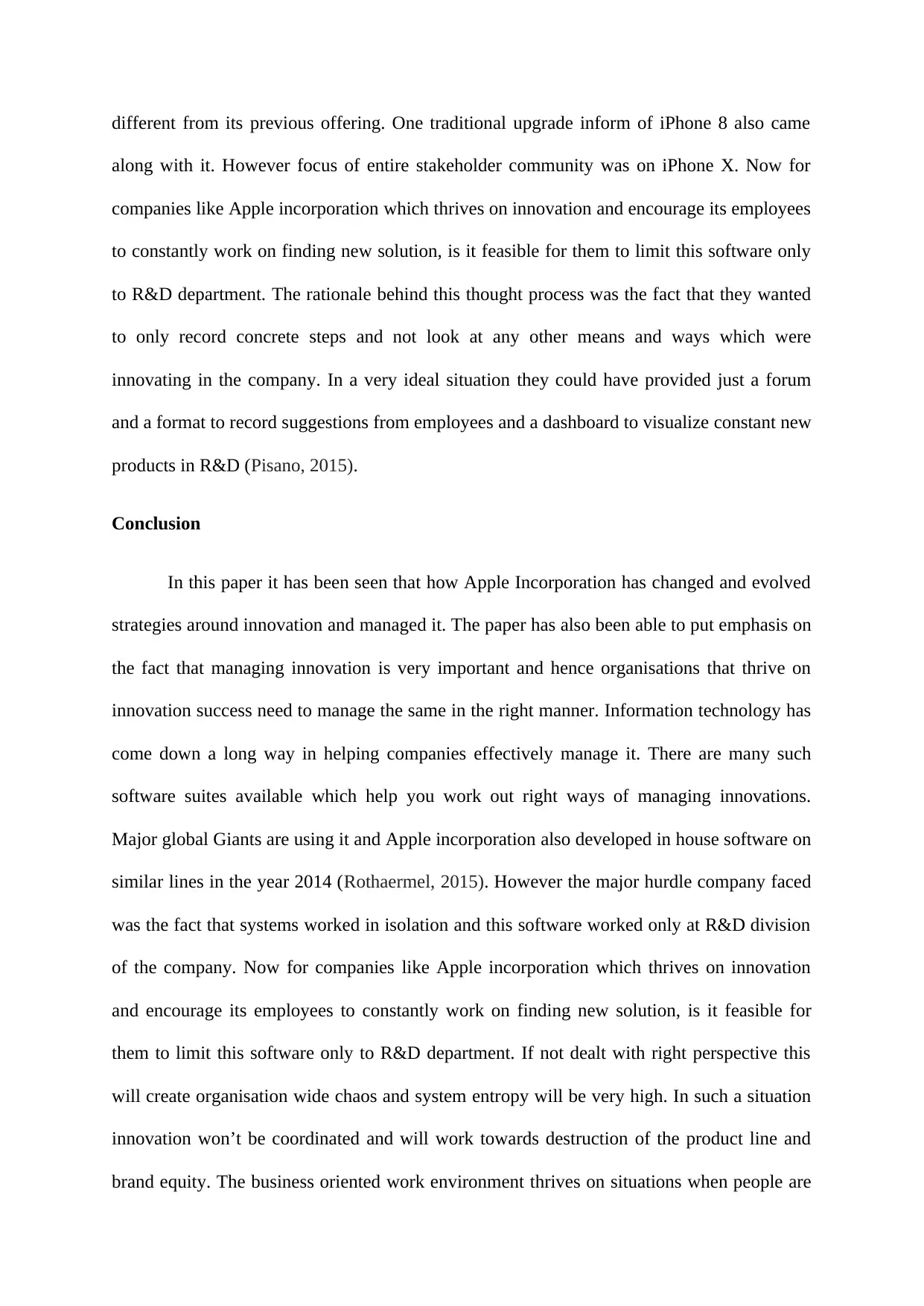
different from its previous offering. One traditional upgrade inform of iPhone 8 also came
along with it. However focus of entire stakeholder community was on iPhone X. Now for
companies like Apple incorporation which thrives on innovation and encourage its employees
to constantly work on finding new solution, is it feasible for them to limit this software only
to R&D department. The rationale behind this thought process was the fact that they wanted
to only record concrete steps and not look at any other means and ways which were
innovating in the company. In a very ideal situation they could have provided just a forum
and a format to record suggestions from employees and a dashboard to visualize constant new
products in R&D (Pisano, 2015).
Conclusion
In this paper it has been seen that how Apple Incorporation has changed and evolved
strategies around innovation and managed it. The paper has also been able to put emphasis on
the fact that managing innovation is very important and hence organisations that thrive on
innovation success need to manage the same in the right manner. Information technology has
come down a long way in helping companies effectively manage it. There are many such
software suites available which help you work out right ways of managing innovations.
Major global Giants are using it and Apple incorporation also developed in house software on
similar lines in the year 2014 (Rothaermel, 2015). However the major hurdle company faced
was the fact that systems worked in isolation and this software worked only at R&D division
of the company. Now for companies like Apple incorporation which thrives on innovation
and encourage its employees to constantly work on finding new solution, is it feasible for
them to limit this software only to R&D department. If not dealt with right perspective this
will create organisation wide chaos and system entropy will be very high. In such a situation
innovation won’t be coordinated and will work towards destruction of the product line and
brand equity. The business oriented work environment thrives on situations when people are
along with it. However focus of entire stakeholder community was on iPhone X. Now for
companies like Apple incorporation which thrives on innovation and encourage its employees
to constantly work on finding new solution, is it feasible for them to limit this software only
to R&D department. The rationale behind this thought process was the fact that they wanted
to only record concrete steps and not look at any other means and ways which were
innovating in the company. In a very ideal situation they could have provided just a forum
and a format to record suggestions from employees and a dashboard to visualize constant new
products in R&D (Pisano, 2015).
Conclusion
In this paper it has been seen that how Apple Incorporation has changed and evolved
strategies around innovation and managed it. The paper has also been able to put emphasis on
the fact that managing innovation is very important and hence organisations that thrive on
innovation success need to manage the same in the right manner. Information technology has
come down a long way in helping companies effectively manage it. There are many such
software suites available which help you work out right ways of managing innovations.
Major global Giants are using it and Apple incorporation also developed in house software on
similar lines in the year 2014 (Rothaermel, 2015). However the major hurdle company faced
was the fact that systems worked in isolation and this software worked only at R&D division
of the company. Now for companies like Apple incorporation which thrives on innovation
and encourage its employees to constantly work on finding new solution, is it feasible for
them to limit this software only to R&D department. If not dealt with right perspective this
will create organisation wide chaos and system entropy will be very high. In such a situation
innovation won’t be coordinated and will work towards destruction of the product line and
brand equity. The business oriented work environment thrives on situations when people are
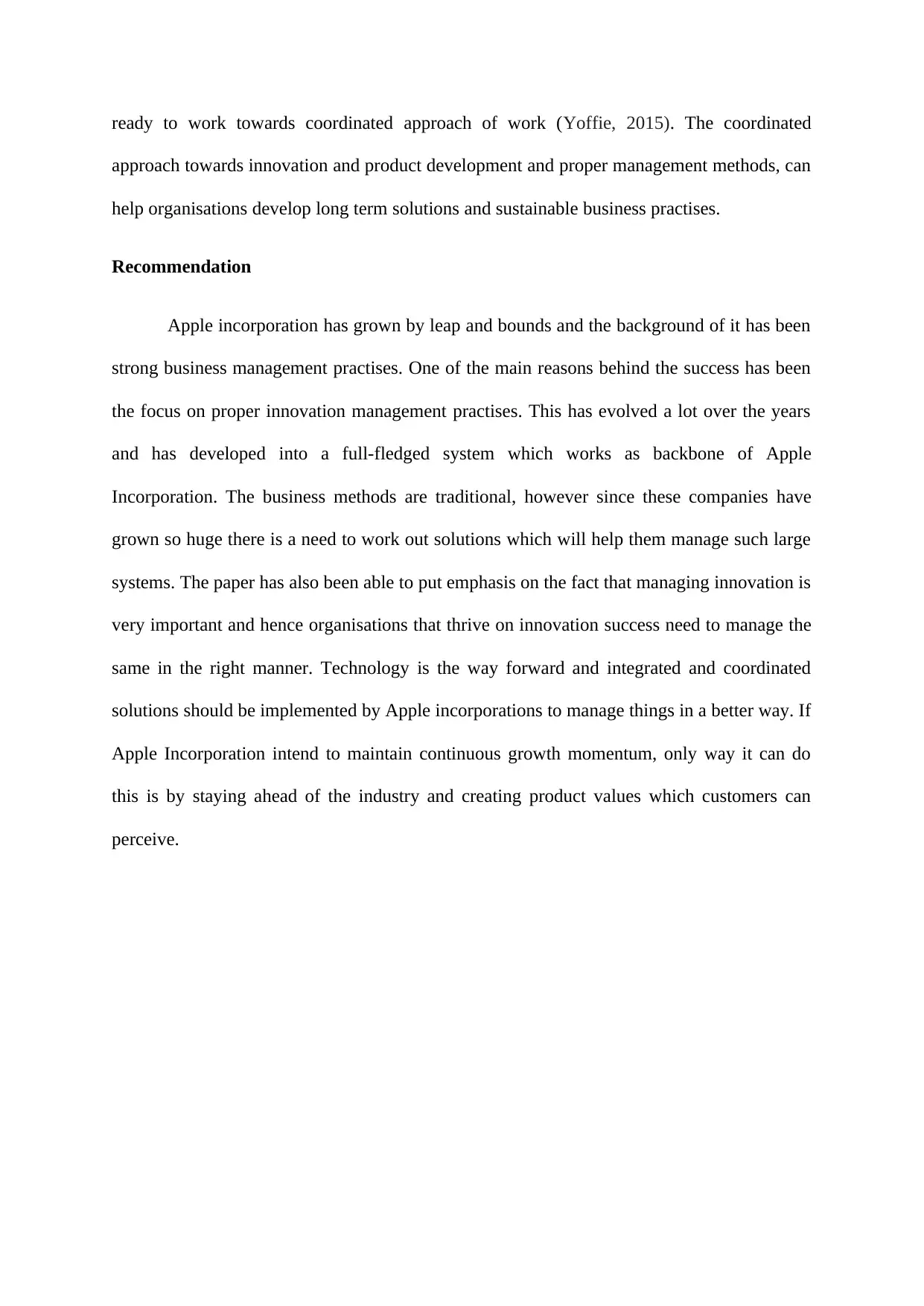
ready to work towards coordinated approach of work (Yoffie, 2015). The coordinated
approach towards innovation and product development and proper management methods, can
help organisations develop long term solutions and sustainable business practises.
Recommendation
Apple incorporation has grown by leap and bounds and the background of it has been
strong business management practises. One of the main reasons behind the success has been
the focus on proper innovation management practises. This has evolved a lot over the years
and has developed into a full-fledged system which works as backbone of Apple
Incorporation. The business methods are traditional, however since these companies have
grown so huge there is a need to work out solutions which will help them manage such large
systems. The paper has also been able to put emphasis on the fact that managing innovation is
very important and hence organisations that thrive on innovation success need to manage the
same in the right manner. Technology is the way forward and integrated and coordinated
solutions should be implemented by Apple incorporations to manage things in a better way. If
Apple Incorporation intend to maintain continuous growth momentum, only way it can do
this is by staying ahead of the industry and creating product values which customers can
perceive.
approach towards innovation and product development and proper management methods, can
help organisations develop long term solutions and sustainable business practises.
Recommendation
Apple incorporation has grown by leap and bounds and the background of it has been
strong business management practises. One of the main reasons behind the success has been
the focus on proper innovation management practises. This has evolved a lot over the years
and has developed into a full-fledged system which works as backbone of Apple
Incorporation. The business methods are traditional, however since these companies have
grown so huge there is a need to work out solutions which will help them manage such large
systems. The paper has also been able to put emphasis on the fact that managing innovation is
very important and hence organisations that thrive on innovation success need to manage the
same in the right manner. Technology is the way forward and integrated and coordinated
solutions should be implemented by Apple incorporations to manage things in a better way. If
Apple Incorporation intend to maintain continuous growth momentum, only way it can do
this is by staying ahead of the industry and creating product values which customers can
perceive.
⊘ This is a preview!⊘
Do you want full access?
Subscribe today to unlock all pages.

Trusted by 1+ million students worldwide
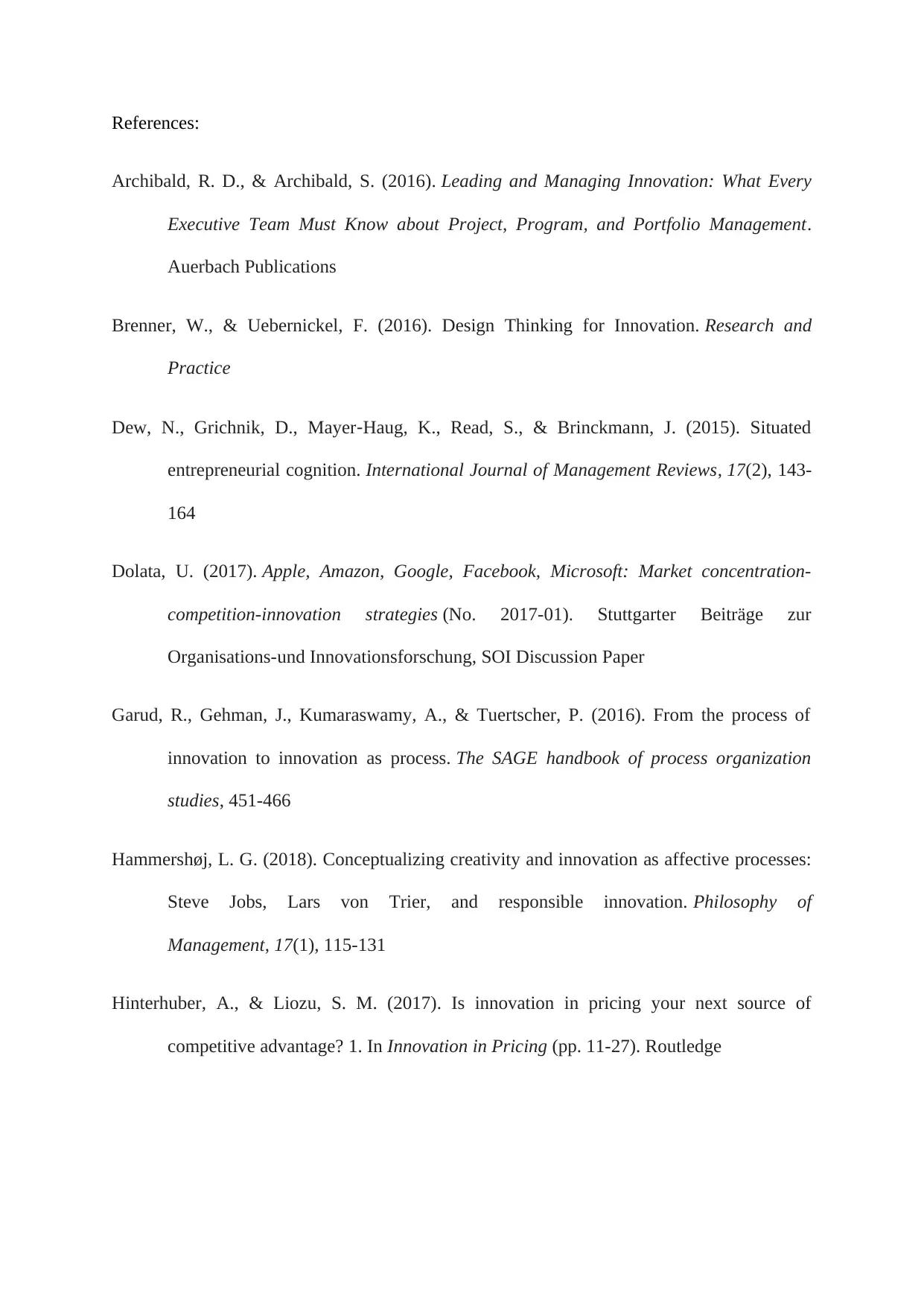
References:
Archibald, R. D., & Archibald, S. (2016). Leading and Managing Innovation: What Every
Executive Team Must Know about Project, Program, and Portfolio Management.
Auerbach Publications
Brenner, W., & Uebernickel, F. (2016). Design Thinking for Innovation. Research and
Practice
Dew, N., Grichnik, D., Mayer‐Haug, K., Read, S., & Brinckmann, J. (2015). Situated
entrepreneurial cognition. International Journal of Management Reviews, 17(2), 143-
164
Dolata, U. (2017). Apple, Amazon, Google, Facebook, Microsoft: Market concentration-
competition-innovation strategies (No. 2017-01). Stuttgarter Beiträge zur
Organisations-und Innovationsforschung, SOI Discussion Paper
Garud, R., Gehman, J., Kumaraswamy, A., & Tuertscher, P. (2016). From the process of
innovation to innovation as process. The SAGE handbook of process organization
studies, 451-466
Hammershøj, L. G. (2018). Conceptualizing creativity and innovation as affective processes:
Steve Jobs, Lars von Trier, and responsible innovation. Philosophy of
Management, 17(1), 115-131
Hinterhuber, A., & Liozu, S. M. (2017). Is innovation in pricing your next source of
competitive advantage? 1. In Innovation in Pricing (pp. 11-27). Routledge
Archibald, R. D., & Archibald, S. (2016). Leading and Managing Innovation: What Every
Executive Team Must Know about Project, Program, and Portfolio Management.
Auerbach Publications
Brenner, W., & Uebernickel, F. (2016). Design Thinking for Innovation. Research and
Practice
Dew, N., Grichnik, D., Mayer‐Haug, K., Read, S., & Brinckmann, J. (2015). Situated
entrepreneurial cognition. International Journal of Management Reviews, 17(2), 143-
164
Dolata, U. (2017). Apple, Amazon, Google, Facebook, Microsoft: Market concentration-
competition-innovation strategies (No. 2017-01). Stuttgarter Beiträge zur
Organisations-und Innovationsforschung, SOI Discussion Paper
Garud, R., Gehman, J., Kumaraswamy, A., & Tuertscher, P. (2016). From the process of
innovation to innovation as process. The SAGE handbook of process organization
studies, 451-466
Hammershøj, L. G. (2018). Conceptualizing creativity and innovation as affective processes:
Steve Jobs, Lars von Trier, and responsible innovation. Philosophy of
Management, 17(1), 115-131
Hinterhuber, A., & Liozu, S. M. (2017). Is innovation in pricing your next source of
competitive advantage? 1. In Innovation in Pricing (pp. 11-27). Routledge
Paraphrase This Document
Need a fresh take? Get an instant paraphrase of this document with our AI Paraphraser
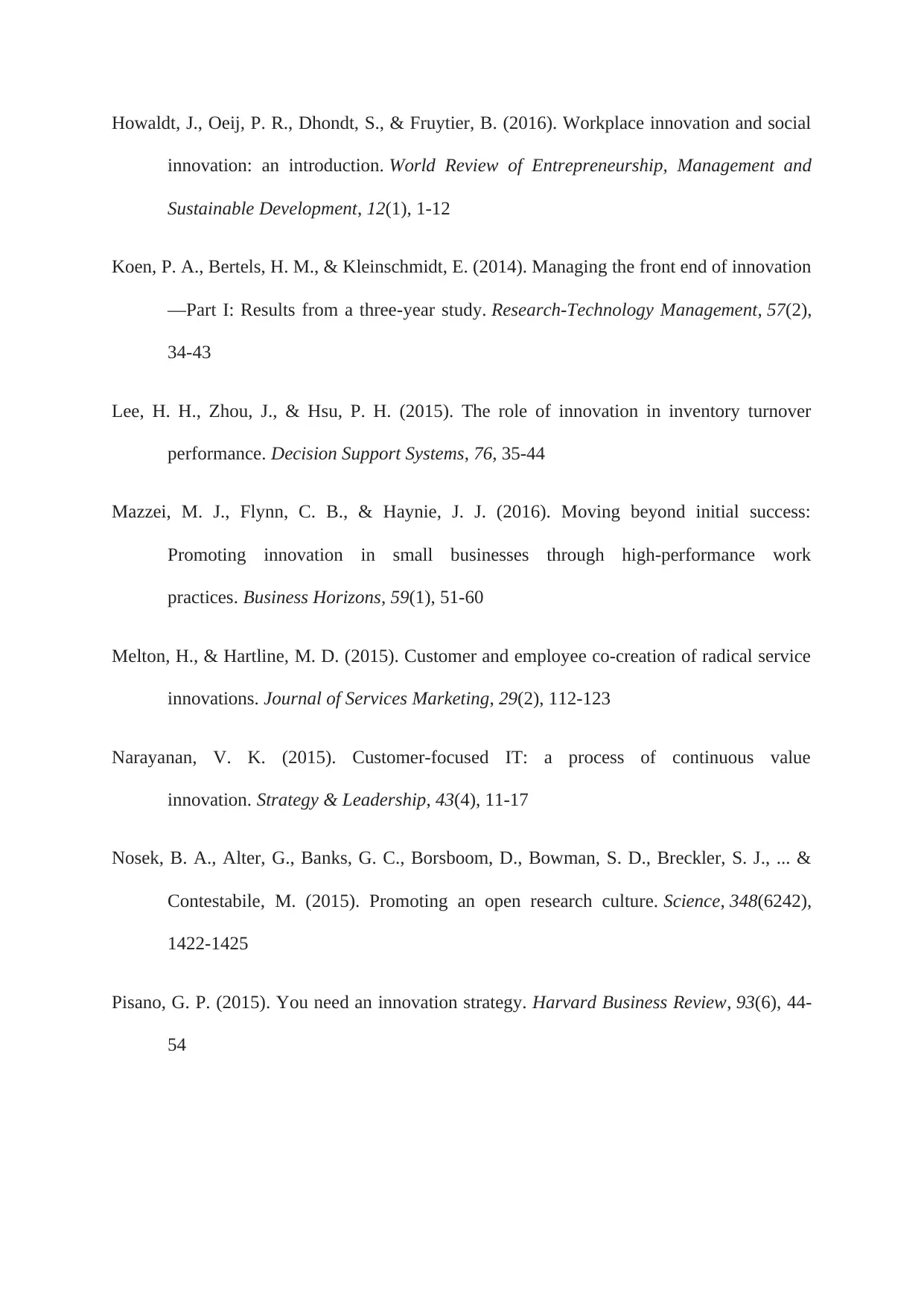
Howaldt, J., Oeij, P. R., Dhondt, S., & Fruytier, B. (2016). Workplace innovation and social
innovation: an introduction. World Review of Entrepreneurship, Management and
Sustainable Development, 12(1), 1-12
Koen, P. A., Bertels, H. M., & Kleinschmidt, E. (2014). Managing the front end of innovation
—Part I: Results from a three-year study. Research-Technology Management, 57(2),
34-43
Lee, H. H., Zhou, J., & Hsu, P. H. (2015). The role of innovation in inventory turnover
performance. Decision Support Systems, 76, 35-44
Mazzei, M. J., Flynn, C. B., & Haynie, J. J. (2016). Moving beyond initial success:
Promoting innovation in small businesses through high-performance work
practices. Business Horizons, 59(1), 51-60
Melton, H., & Hartline, M. D. (2015). Customer and employee co-creation of radical service
innovations. Journal of Services Marketing, 29(2), 112-123
Narayanan, V. K. (2015). Customer-focused IT: a process of continuous value
innovation. Strategy & Leadership, 43(4), 11-17
Nosek, B. A., Alter, G., Banks, G. C., Borsboom, D., Bowman, S. D., Breckler, S. J., ... &
Contestabile, M. (2015). Promoting an open research culture. Science, 348(6242),
1422-1425
Pisano, G. P. (2015). You need an innovation strategy. Harvard Business Review, 93(6), 44-
54
innovation: an introduction. World Review of Entrepreneurship, Management and
Sustainable Development, 12(1), 1-12
Koen, P. A., Bertels, H. M., & Kleinschmidt, E. (2014). Managing the front end of innovation
—Part I: Results from a three-year study. Research-Technology Management, 57(2),
34-43
Lee, H. H., Zhou, J., & Hsu, P. H. (2015). The role of innovation in inventory turnover
performance. Decision Support Systems, 76, 35-44
Mazzei, M. J., Flynn, C. B., & Haynie, J. J. (2016). Moving beyond initial success:
Promoting innovation in small businesses through high-performance work
practices. Business Horizons, 59(1), 51-60
Melton, H., & Hartline, M. D. (2015). Customer and employee co-creation of radical service
innovations. Journal of Services Marketing, 29(2), 112-123
Narayanan, V. K. (2015). Customer-focused IT: a process of continuous value
innovation. Strategy & Leadership, 43(4), 11-17
Nosek, B. A., Alter, G., Banks, G. C., Borsboom, D., Bowman, S. D., Breckler, S. J., ... &
Contestabile, M. (2015). Promoting an open research culture. Science, 348(6242),
1422-1425
Pisano, G. P. (2015). You need an innovation strategy. Harvard Business Review, 93(6), 44-
54
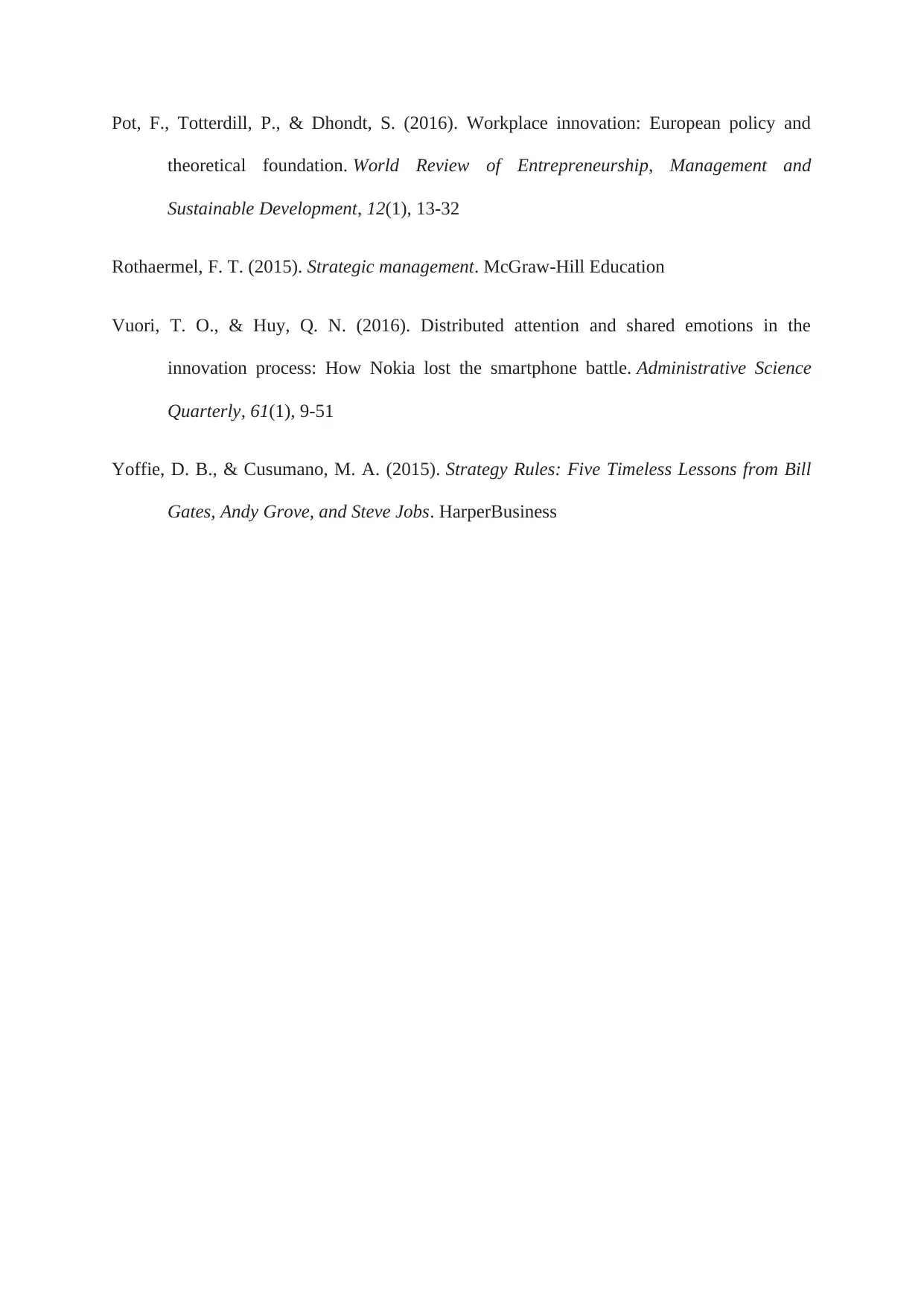
Pot, F., Totterdill, P., & Dhondt, S. (2016). Workplace innovation: European policy and
theoretical foundation. World Review of Entrepreneurship, Management and
Sustainable Development, 12(1), 13-32
Rothaermel, F. T. (2015). Strategic management. McGraw-Hill Education
Vuori, T. O., & Huy, Q. N. (2016). Distributed attention and shared emotions in the
innovation process: How Nokia lost the smartphone battle. Administrative Science
Quarterly, 61(1), 9-51
Yoffie, D. B., & Cusumano, M. A. (2015). Strategy Rules: Five Timeless Lessons from Bill
Gates, Andy Grove, and Steve Jobs. HarperBusiness
theoretical foundation. World Review of Entrepreneurship, Management and
Sustainable Development, 12(1), 13-32
Rothaermel, F. T. (2015). Strategic management. McGraw-Hill Education
Vuori, T. O., & Huy, Q. N. (2016). Distributed attention and shared emotions in the
innovation process: How Nokia lost the smartphone battle. Administrative Science
Quarterly, 61(1), 9-51
Yoffie, D. B., & Cusumano, M. A. (2015). Strategy Rules: Five Timeless Lessons from Bill
Gates, Andy Grove, and Steve Jobs. HarperBusiness
⊘ This is a preview!⊘
Do you want full access?
Subscribe today to unlock all pages.

Trusted by 1+ million students worldwide
1 out of 12
Related Documents
Your All-in-One AI-Powered Toolkit for Academic Success.
+13062052269
info@desklib.com
Available 24*7 on WhatsApp / Email
![[object Object]](/_next/static/media/star-bottom.7253800d.svg)
Unlock your academic potential
Copyright © 2020–2025 A2Z Services. All Rights Reserved. Developed and managed by ZUCOL.





